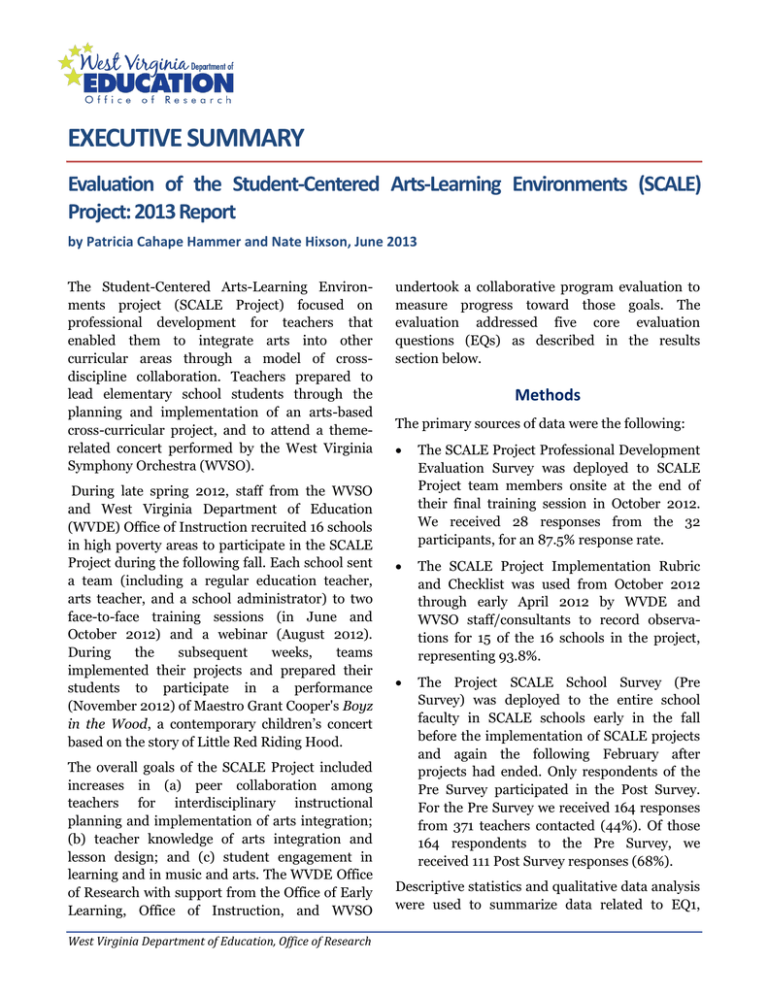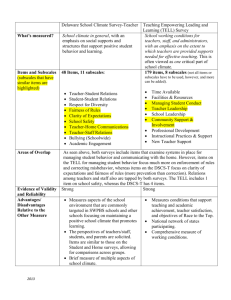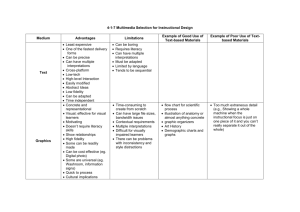EXECUTIVE SUMMARY Project: 2013 Report
advertisement

EXECUTIVE SUMMARY Evaluation of the Student-Centered Arts-Learning Environments (SCALE) Project: 2013 Report by Patricia Cahape Hammer and Nate Hixson, June 2013 The Student-Centered Arts-Learning Environments project (SCALE Project) focused on professional development for teachers that enabled them to integrate arts into other curricular areas through a model of crossdiscipline collaboration. Teachers prepared to lead elementary school students through the planning and implementation of an arts-based cross-curricular project, and to attend a themerelated concert performed by the West Virginia Symphony Orchestra (WVSO). During late spring 2012, staff from the WVSO and West Virginia Department of Education (WVDE) Office of Instruction recruited 16 schools in high poverty areas to participate in the SCALE Project during the following fall. Each school sent a team (including a regular education teacher, arts teacher, and a school administrator) to two face-to-face training sessions (in June and October 2012) and a webinar (August 2012). During the subsequent weeks, teams implemented their projects and prepared their students to participate in a performance (November 2012) of Maestro Grant Cooper's Boyz in the Wood, a contemporary children’s concert based on the story of Little Red Riding Hood. The overall goals of the SCALE Project included increases in (a) peer collaboration among teachers for interdisciplinary instructional planning and implementation of arts integration; (b) teacher knowledge of arts integration and lesson design; and (c) student engagement in learning and in music and arts. The WVDE Office of Research with support from the Office of Early Learning, Office of Instruction, and WVSO West Virginia Department of Education, Office of Research undertook a collaborative program evaluation to measure progress toward those goals. The evaluation addressed five core evaluation questions (EQs) as described in the results section below. Methods The primary sources of data were the following: The SCALE Project Professional Development Evaluation Survey was deployed to SCALE Project team members onsite at the end of their final training session in October 2012. We received 28 responses from the 32 participants, for an 87.5% response rate. The SCALE Project Implementation Rubric and Checklist was used from October 2012 through early April 2012 by WVDE and WVSO staff/consultants to record observations for 15 of the 16 schools in the project, representing 93.8%. The Project SCALE School Survey (Pre Survey) was deployed to the entire school faculty in SCALE schools early in the fall before the implementation of SCALE projects and again the following February after projects had ended. Only respondents of the Pre Survey participated in the Post Survey. For the Pre Survey we received 164 responses from 371 teachers contacted (44%). Of those 164 respondents to the Pre Survey, we received 111 Post Survey responses (68%). Descriptive statistics and qualitative data analysis were used to summarize data related to EQ1, including measures of central tendency and dispersion (e.g., mean/standard deviation) as well as percentages of respondents indicating specific perceptions of the SCALE program. Likewise for EQ2, we used descriptive statistics to summarize implementation fidelity data, describing the number and proportion of schools that met adequate fidelity on the core indicators noted above. To address EQ3, EQ4, and EQ5, we conducted a series of paired t tests whereby we ascertained if changes from preto postintervention were statistically significant and in the predicted direction, and we used Hedge’s g test to determine if changes observed were substantively important. Results Evaluation Question 1. What was the quality of the training and technical assistance that was provided to SCALE Project schools? Professional development offered to participants in the SCALE Project was well attended and well received. The overall ratings were remarkably high, with participants strongly agreeing about the high quality of the training and trainers on multiple measures, and approaching strong agreement about the high quality of the materials provided. The comments from participants also strongly praised the program, materials, and trainers. A few indicated they did not feel prepared to implement the project in their schools—that is, they still had lots of questions— after the summer professional development, but when they had completed all three training events, they indicated they were looking forward to using what they had learned back in their schools and classrooms. Overall, based on participant perceptions, SCALE Project team leaders were well trained to facilitate the program in their schools. Evaluation Question 2. How well did the SCALE Project schools implement the central components of the program? Rubric and benchmark data provided by West Virginia Symphony Orchestra (WVSO) and West 2 | EXECUTIVE SUMMARY Evaluation of the SCALE Project Virginia Department of Education (WVDE) personnel indicated that in most schools, the SCALE Project was well implemented (80%). As a group, rubric data indicated that schools saw the greatest level of implementation relative to student engagement in the arts and the lowest level of implementation relative to improving lesson design. Other data showed the following: (a) there was agreement or strong agreement that student engagement was high on all measures; (b) in the large majority of schools, at least six of 10 role groups were involved in the project, with Title I teachers, physical education teachers, parents, and community members the most commonly not involved; (c) the arts were well integrated into the SCALE school projects; and (d) the large majority of schools implemented eight of nine major SCALE Project components. Implementation was far from even, however. Four schools had implementation rates above 90% (high-implementation schools), while four had implementation rates below 75%, ranging down to 51% (low-implementation schools). For those that had lower levels of implementation, several issues seemed to be the most common: (a) forming a team; (b) arranging for it to meet regularly; (c) limited arts integration professional development for staff; (d) limited involvement of content areas other than the arts; or (e) involvement of only some, not all, of their classrooms. The unevenness in implementation did not seem related to previous experience with the program (i.e., all four low-implementation schools had previous experience with the SCALE Project, as did three of the four high-implementation schools), nor with schools’ involvement in the School Improvement Grant (SIG) program (half of the low implementation and half of the high implementation schools were SIG schools). Although it is not possible to say with certainty, successful implementation seemed related to the school’s commitment to the project—which included establishing an active, multidisciplinary team, strong collaboration, and involvement of the whole school. Evaluation Question 3. To what extent did the SCALE Project result in increased student engagement in music and the arts and in other content areas? SCALE school teacher surveys conducted before and after implementation of the project contained three subscales measuring educators’ perceptions of student affective, behavioral, and cognitive engagement in the arts and other content areas. All three subscales showed small improvements, although only one, behavioral engagement, approached statistical significance. When looking at individual survey items that made up the subscales, two interesting findings emerged— teachers reported small positive effects for students staying on task and for student motivation. When comparing schools with prior experience in SCALE with those new to the project, there were small but substantively important positive changes in both behavioral and cognitive engagement for schools new to SCALE. Looking at individual items, we found two of the strongest effects we detected in the study: Teachers in newimplementation schools reported higher levels of students staying on task at Post Survey than at Pre Survey and higher levels of students believing they were learning in their classes. For priorimplementation schools we found there were slightly lower perceptions of the extent to which students were excited about their schoolwork at Post Survey. As noted in the discussion of EQ2, there were large differences among the schools in their levels of implementation, so we looked at what bearing, if any, implementation fidelity had on changes between Pre and Post Survey. With respect to overall subscale scores, we found that educators in high-fidelity schools reported both higher overall behavioral and cognitive engagement among students at Post Survey than at Pre Survey. When we looked a little deeper at individual student engagement items, educators in high-fidelity schools at Post Survey reported (a) students stayed on task more, (b) preferred more challenging assignments, and (c) followed instructions better. Evaluation Question 4. To what extent did the SCALE Project impact culture and climate in participating schools? Our analysis of pre- and posttest responses to school culture items on the school survey revealed no statistically significant or substantively important changes from pre- to post-test data collections on any of the four subscales. These findings held when we disaggregated the responses by new or prior implementation and by high- and low-implementation fidelity. This is not surprising for such a brief intervention such as the SCALE Project. For an intervention that lasted only a few months, it would be unusual to see significant changes. Evaluation Question 5. To what extent did the SCALE Project result in improved lesson design and/or instructional delivery among participating schools? We constructed three subscales in the Project SCALE School Survey (Pre and Post Survey versions) for lesson design and instructional delivery to measure (a) integration of arts content into instruction, (b) collaboration among faculty role groups and community members in lesson design, and (c) collaboration among school-based teams in lesson planning. We found no statistically significant or substantively important changes at the subscale level for the whole group, nor for schools disaggregated by experience with the SCALE Project (new versus prior), nor for schools disaggregated by level of fidelity of implementation (high versus low). We also disaggregated responses by content area (arts versus other content areas), and again did not find changes to report. When looking at individual items, however, there were several interesting—albeit small effects at Post Survey: Teachers from new-implementation schools reported more collaboration with community members in the development of their lessons, and more integration of dance/movement strategies into their own instruction. Non-arts elementary teachers reported more integration of dance/movement strategies EXECUTIVE SUMMARY Evaluation of the SCALE Project | 3 into their own instruction, collaboration with arts teachers. and more Teachers from high-implementation-fidelity schools reported less integration of creative writing instructional strategies, and more integration of dance instructional strategies. schools realized more positive outcomes than prior-implementation schools. The excitement factor in new schools could have contributed to these findings. Encourage and support full implementation of all components of the program. We found that higher-than-average implementation fidelity schools experienced more positive outcomes than those schools that did not implement many components with fidelity. We found no significant changes for lowerthan-average implementation schools. That is, while failure to implement the program as intended is not necessarily associated with negative outcomes, it does potentially maintain the status quo. Program staff should use these results as a catalyst for participating schools, to illustrate that a school’s level of commitment can make or break the project. Ensure that schools participating in the project build in sufficient common planning time to support the necessary collaboration. This time is essential to ensure the school’s project is implemented with fidelity and achieves the intended school-wide outcomes. Administrator support is critical in this regard and should be discussed early on in the project. Develop strategies to ensure that once the school project concludes, the faculty does not return to business as usual. One strategy may be finding ways to sustain the momentum of the project—that is to continue on with other collaborative projects that integrate various content areas, including the arts. Another strategy may involve addressing beliefs that time spent on a project such as SCALE is time taken away from improving test scores in mathematics and reading/language arts. Helping educators understand the strong connections between high student cognitive and behavior engagement—as seen in many of the SCALE schools this year—and high student achievement could help reduce the anxiety felt about making the sorts of changes in lesson planning and instruction that the SCALE project encouraged. Limitations of the Study Several limitations of this study bear mentioning. First, all data are self-reported and thus subject to various threats to validity, such as social desirability bias (when respondents provide overly positive responses to a survey or questionnaire due to their desire to be viewed favorably) or nonresponse bias (when respondents who elect not to participate in a survey differ in a meaningful way with those who do). We encountered one technical difficulty, when we unintentionally excluded an item in one of the subscales drawn from the POSC instrument. To compensate for the missing item, we applied a multiplier. There is a small possibility that the validity of the measure was affected, but there was little or no change in these measures, so this error did not impact our findings in any meaningful way. Another limitation of our study involves our inability to draw school-level conclusions regarding the impact of the various projects implemented by schools, because we did not receive a large number of completed surveys from many schools to make such disaggregation possible. Recommendations We make the following recommendations based upon our results: To the extent possible, we recommend continuing this project. Educators appear to perceive positive benefits of the program for their students especially in the areas of cognitive and behavioral engagement. These are important outcomes that could lead to improved student achievement if sustained. Efforts should be made to sustain initial excitement so that prior implementation schools can continue to realize benefits. In this study, we found that new implementation 4 | EXECUTIVE SUMMARY Evaluation of the SCALE Project





